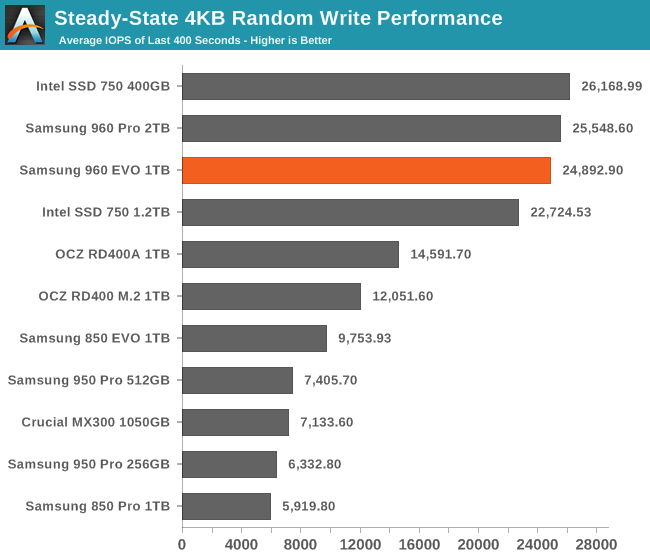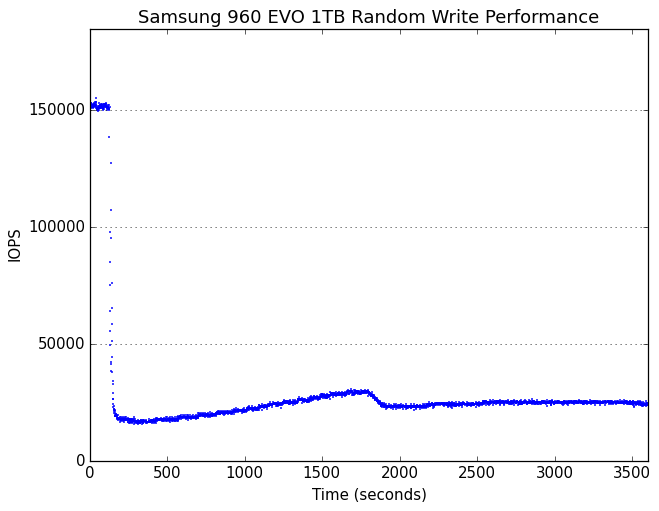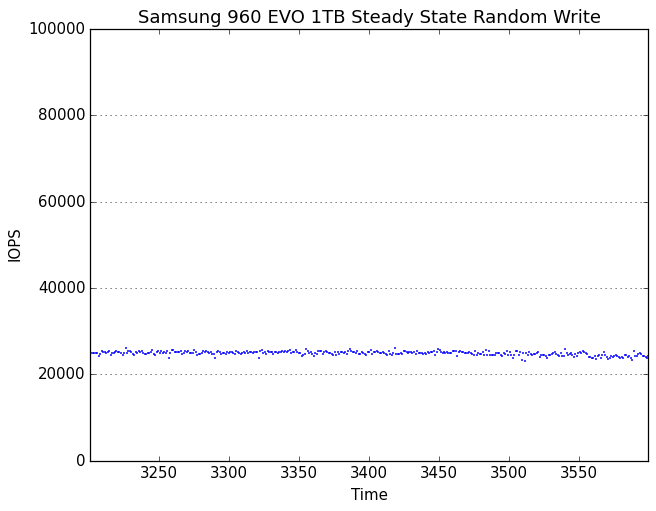The Samsung 960 EVO (1TB) Review
by Billy Tallis on November 15, 2016 10:00 AM ESTPerformance Consistency
Our performance consistency test explores the extent to which a drive can reliably sustain performance during a long-duration random write test. Specifications for consumer drives typically list peak performance numbers only attainable in ideal conditions. The performance in a worst-case scenario can be drastically different as over the course of a long test drives can run out of spare area, have to start performing garbage collection, and sometimes even reach power or thermal limits.
In addition to an overall decline in performance, a long test can show patterns in how performance varies on shorter timescales. Some drives will exhibit very little variance in performance from second to second, while others will show massive drops in performance during each garbage collection cycle but otherwise maintain good performance, and others show constantly wide variance. If a drive periodically slows to hard drive levels of performance, it may feel slow to use even if its overall average performance is very high.
To maximally stress the drive's controller and force it to perform garbage collection and wear leveling, this test conducts 4kB random writes with a queue depth of 32. The drive is filled before the start of the test, and the test duration is one hour. Any spare area will be exhausted early in the test and by the end of the hour even the largest drives with the most overprovisioning will have reached a steady state. We use the last 400 seconds of the test to score the drive both on steady-state average writes per second and on its performance divided by the standard deviation.

The 960 EVO's steady state random write speed is not quite as fast as the 960 Pro, but it's in the same league and much faster than most consumer SSDs.

The 960 EVO sets a new record for combining high performance with consistency. It's a bit slower than the 960 Pro, but less variable.
 |
|||||||||
| Default | |||||||||
| 25% Over-Provisioning | |||||||||
Highly consistent performance is a good thing, but it makes for a boring graph. The transitions from peak to sustained performance modes look the same for both the 960 Pro and the 960 EVO.
 |
|||||||||
| Default | |||||||||
| 25% Over-Provisioning | |||||||||
The 960 EVO responds to extra overprovisioning with even more consistent (and high) performance.










87 Comments
View All Comments
ddriver - Tuesday, November 15, 2016 - link
TOMs has tested it. As expected, it is marginally slower.Bensant - Tuesday, November 15, 2016 - link
Just received my 960 Pro today, installed and everything is working properly apart from the Samsung driver. Have spent the last 40mins trying to locate the NVME 2.0 driver to no avail. Would anyone have a link to it yet? Or is it still unavailable and coming with the new magician software at the end of the month?XabanakFanatik - Wednesday, November 16, 2016 - link
Yeah, you should be able to use the version 1.0 driver until they finally get around to releasing the new one with Magician 5.0.What capacity pro did you buy that you actually received this early? 512GB?
Bensant - Wednesday, November 16, 2016 - link
Idk that's a bit funny then, the original drivers (For the 950 pro) failed to detect my 960 pro for some reason. It's been installed and is booting as my OS drive too, just using the Microsoft driver!And yeah, was the 512GB that I ordered, couldn't exactly justify getting the higher capacities after just spending more then $4000 on a new triple monitor setup haha
jeffbui - Wednesday, November 16, 2016 - link
Benchmarks are great but where are the real world measurements? How will this affect me vs the other drives?jeffbui - Wednesday, November 16, 2016 - link
http://www.anandtech.com/show/2614Look at all the real world measurements: Game load times, application load times, multitasking performance,
Billy Tallis - Thursday, November 17, 2016 - link
Kristian did a good job of explaining why we rely on playing back traces of real-world I/O rather than re-running the applications themselves: http://www.anandtech.com/show/8979/samsung-sm951-5...It has only gotten more impractical to build a valid and reproducible application benchmark suite, to the point that any such system would have to be cut off from the Internet to prevent automatic updates from changing the conditions of the test.
From the perspective of the SSD, our ATSB trace-based tests present a nearly identical workload to running the applications themselves, but with far better reproducibility. It might be possible to improve how we present the results of those three tests, but I do not believe that splitting those traces into a dozen different scenarios would make it any easier to come to a purchasing decision than by considering the measurements we currently report.
RaistlinZ - Wednesday, November 16, 2016 - link
I'm currently using an 850 EVO on my ASUS X99 Pro motherboard. Will my mobo fully support the 960? Also, is it better to do a fresh Windows 10 install on an NVMe drive, or does cloning still work well?ghojezz - Wednesday, November 16, 2016 - link
I don't understand, anandtech's using Z97 Deluxe for benchmark but it only supports 10Gbps M.2 Bandwidth, right? So theoretically, you didn't push 960 to its max performance. Anyone care to explain?Billy Tallis - Thursday, November 17, 2016 - link
The motherboard's built-in M.2 slot is not used, because it does not permit measuring power consumption. M.2 PCIe drives are connected through an adapter and riser card to the primary PCIe 3.0 x16 slot, which will continue to be sufficient until PCIe 4 SSDs and motherboards arrive.